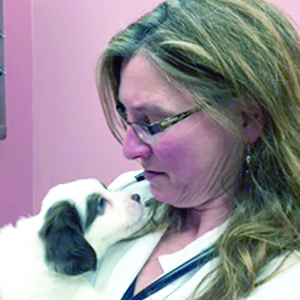
Episode 54
Tech Support, Part II: One Problem, Many Voices
Tackling the Technician Shortage Series See All Episodes »
What is behind the widespread shortage of technicians, and what can be done to reverse it? It’s a complicated question many organizations are asking but no one has yet been able to answer. In 2021, OVMA established a task force to investigate this worsening trend, and in the past year, it has dug deep into the root of the problem in an effort to better understand its complexities and identify potential solutions.
In the pilot episode of Fully Vetted’s Tackling the Technician Shortage Series, we met Dr. Diana Cron, technician Kelley Norris, and Dr. Jennifer Wells of OVMA’s Technician Recruitment & Retention Task Force. They offered a brief history of the technician shortage, explored the factors that laid the groundwork, and discussed how the profession as a whole has been impacted.
In this, the second installment of the three-episode series, we explore a trio of unique but intertwined perspectives on the same issue—those of the veterinary technician, the practice owner, and the educator. Our guests also delve into the results of a task force-led survey, focusing on reasons technicians cite for staying at or leaving a practice—or the profession altogether.
The discussion sets the stage for the series conclusion, in which we’ll look at the current state of technician education and training; possible improvements for the future; and ways veterinarians and practice owners can improve the technician experience to keep them happy, healthy, and employed.
Episode Guests

Diana Cron
DVM
Dr. Cron serves on the OVMA Board of Directors and is co-owner of Glenway Animal Hospital in Cincinnati.
Learn More »

Kelley Norris
RVT
Kelley is the assistant director of companion animal patient care at OSU Veterinary Medical Center.
Learn More »

Jennifer Wells
DVM
A former technician, Dr. Wells is the program director of the University of Cincinnati Blue Ash Veterinary Technology Program
Learn More »
Transcript
Krysten Bennett: We are here with Dr. Diana Cron, Dr. Jennifer Wells, and RVT Kelley Norris. Welcome back, ladies.
In the last episode, we discussed the background of the technician shortage and the OVMA task force that was formed to dig in to the roots of the problem and how it’s impacted the profession. We finished up with a discussion of how the COVID pandemic has made the situation worse. In other words, we established that, one, this is a really complex issue, and two, it’s not going away anytime soon. So, with that in mind, let’s pick up the conversation where we left off.
Just like any complex issue, there’s always going to be two sides to the coin. And of course, it certainly benefits everyone involved to hear one another’s point of view. Let’s delve into those perspectives a bit, starting with the technician side. Kelley, can you break down the technician’s experience for those of our listeners who may not understand this point of view?
Kelley Norris: The living wage in Ohio is $29.33 an hour. Starting salaries are a little bit better now, but at the beginning of kind of the crisis point of this shortage, people were getting hired in at $13 or $14 an hour. And so a lot of technicians have had two or three jobs to try and earn a living wage. That’s not very conducive to any sort of work/life balance, and that was really tough on people.
The other thing truly goes back to being valued and being utilized to the best potential, because you can get by a little less money if you feel like you’re an important part of the team, and if you feel like your team and the patients and clients that you are serving respect you. I think that, as I said, a lot of outside people from the profession don’t understand what it is that we do, and that is hurtful. And a lot of technicians felt like they could go into human medicine and do basically the same job on people instead of animals and have a lot more respect and have a better salary and work/life balance in the process.
Mia Cunningham: So, Dr. Cron, as a veterinarian and hospital owner, can you share the veterinarian’s perspective?
Diana Cron: We have done just about everything we can do in order to find technicians, and we could actually use another veterinarian or two at our practice as well. We’ve done online searches. We’ve reached out to Ohio State and other places. We provide excellent benefits for our staff. We provide health insurance for full-time people. We even pay part of a gym membership if people want it. We have a lot of different things that we do, but we’ve done just about everything that we can do. Managing all that is a lot of work as well.
And traditionally, you’re supposed to have a certain percentage of dollars set aside for payroll and a certain percentage for inventory and for things like that. So it’s very difficult to just come in and say, “Okay, everybody’s going to get 15 percent raises,” or something like that and still be profitable and be able to pay all your bills, making sure that all those figures stay in line. It’s a lot of work to keep all those balls in the air, but there’s only so many hours in the day that you can spend doing those kinds of things when you’ve got a full caseload.
KB: Dr. Wells, as a veterinarian who educates future technicians, you have a unique perspective on this issue. What insights can you add?
Jennifer Wells: We have a challenge on the educator side that we’re trying to get more in the profession to help alleviate this problem. We know that regardless of the profession, people are going to switch jobs. That’s not inherent just to veterinary medicine or to veterinary technology. That happens a lot in other professions as well. But it happens at a higher rate for our technicians. By the Ohio Workman Labor estimates, there’s supposed to be a 15 percent growth in need for veterinary technicians in the next 10 years. We’re not even meeting the need now because of the attrition of people that are leaving the profession.
We have a lot of veterinary technology schools in Ohio, and we try to graduate entry-level technicians that can be trained and work in the profession for a very long period of time, but there are a lot of reasons that they may leave. And as Kelley said, it’s very difficult to support yourself, even as our profession is seeing an increase in our starting salaries. We’re required by the AVMA to do graduate surveys every year. And just this spring, we did a survey on all of our graduates, and we’re finally seeing starting salaries where they probably should have been for the last five to 10 years, up in that $17 to $18 an hour range, which is wonderful, much better than the an hour that Kelly said earlier. But it’s still not a living wage.
And yes, we are female-dominated profession. Yes, many women have a significant other who may help support them. But if you don’t, or if you have children or if you don’t have family support, it’s not something that you can sustain long term working two jobs or trying to work the night shift to make that shift differential or whatever it takes to make enough money to live off of. So there’s a lot going into it from both sides.
I think a lot of practices are doing a really good job of valuing their technicians and keeping them there. But sometimes even the best clinics are losing them to reasons that they can’t control.
KN: More recently, as Dr. Wells said, we have been seeing increasing starting salaries. A lot of practices and specialty practices and referral centers are also paying starting bonuses, new graduate bonuses, new hire bonuses, retention bonuses to those staff that they have and really trying to increase the incentives for people to come. But until Dr. Wells and all the other schools get their quota filled, it’s still not enough. So even with everyone kind of trying to get the same people, we need more people to really solve the problem.
MC: In the fall of 2021, the task force conducted a survey of both Ohio veterinarians and technicians in an effort to understand how the situation came to be. Sounds like there was quite a few responses, so we got over 800 responses. What were some of the highlights from the results?
DC: One of the top reasons that technicians wanted to leave a practice that they were in was a toxic work culture. But one of the reasons that they stayed was a good work culture. So things like communicating with your coworkers and being respected and those kinds of things are what people valued. And compensation and work/life balance, all the things that we’ve talked about before that. Those were some of the highlights.
KB: Dr. Cron, you touched on the crux of this survey and the reason why this task force was formed to begin with. What are some of the reasons that technicians cited for leaving a practice or even leaving the profession altogether?
DC: When we did our survey, the top three reasons technicians decided for leaving their practice were compensation, work/life balance, and culture. Toxic workplaces are not good for people; they don’t want to come to work, and those kinds of things make people want to leave.
I think there’s a lot of other reasons that people leave as well. A lot of other people cited things like lack of training, no opportunity for advancement, scheduling conflicts, underutilization of skills. Sometimes people leave just because they have to take care of an elderly parent or child. We’ve had technicians that have left to go into research, and then recently we had one that wanted to be a ballet dancer and then one that went off to be a brewmaster. So, I mean, there’s a variety of different reasons that people leave the profession.
And I do think that being an RVT in a busy practice is a lot easier when you’re younger and have fewer family responsibilities, more stamina, and fewer aches and pains. I think it’s a lot easier to be on your feet all day restraining animals and doing all the things that registered veterinary technicians do. So, I think that the job of the profession for some people has a finite shelf life, if you will—unless they feel like there’s opportunity for advancement, they can move up in the practice hierarchy, and they can actually do what they really want to do.
JW: I’d like to piggyback off of that too, that I think it’s really important to recognize that it’s not just about pay. I think pay is a good motivator to get people into the profession, so that we can show that you can make a living wage. Maybe not when you first graduate, but within five years or something, you should be able to make a living wage.
But it’s also really important to acknowledge that respect and utilization are really highly valued by technicians. And a lot of technicians said that they stayed in practices where they weren’t making the highest amount of money, because they enjoyed their coworkers; they felt respected and valued by the practice manager and the veterinarians that work there. And a lot of that part, it can be a really difficult culture change if you’re not in a practice that already does that. But that doesn’t cost a lot. You know, that’s not giving them $5 more an hour. That’s maybe getting them different colored scrubs or making sure that all of the registered veterinary technicians say “registered veterinary technician” on their name tags and nobody else does; they say “veterinary assistant.” You know, really delineating who that person is and what their role is in the practice and letting them practice to the fullest of their abilities. But also, supporting those that support the technician: Having assistants there that are doing everything that assistants can do so that the technician doesn’t have to do all of those skills—which those highly trained assistants are capable of doing, certainly.
So I think that’s really important to recognize as well. Even though pay is obviously a big sore spot for a lot of people, it’s not everything. And a lot of people stay in practices where they’re not making the highest salaries because of those relationships and that respect that they’re getting.
I also wanted to point out, too, that a lot of veterinary practices are helping subsidize tuition for veterinary assistants to go on to become veterinary technicians. And I think anybody that works in a practice, you probably know you’ve got that really highly performing veterinary assistant and you’re like, gosh, “I wish they would go to school to become an RVT.” Incentivize that. Make a contract, a legally binding contract, that you’ll help pay them to go to school, even if it’s part time, to a program where they can continue working. Then when they graduate, they have to stay with you for X number of years. There are a lot of practices doing that. And again, 27 percent of our responding veterinarians said that they were already doing that, and over half said that they would consider doing it. That could even be an incentive for hiring assistants: “You know, we can’t pay you $25 an hour, but we’ll help subsidize the cost of you going to school so you can get registered.” So I think that is an area that some practices could certainly explore that’s a great way to get RVTs.



